
 Copyright © Michael Richmond.
This work is licensed under a Creative Commons License.
Copyright © Michael Richmond.
This work is licensed under a Creative Commons License.
Contents
Executive summary:

The Large Hadron Collider (LHC) is a big physics experiment. Two groups of protons are accelerated in opposite directions as they fly around a very large ring, then smashed into each other.
The main ring is the largest particle accelerator in the world, with a diameter of about 5.34 miles. For comparison, the ring at Fermilab is only 1.24 miles in diameter.
Actually, the protons pass through four small accelerators before they reach the big LHC itself.
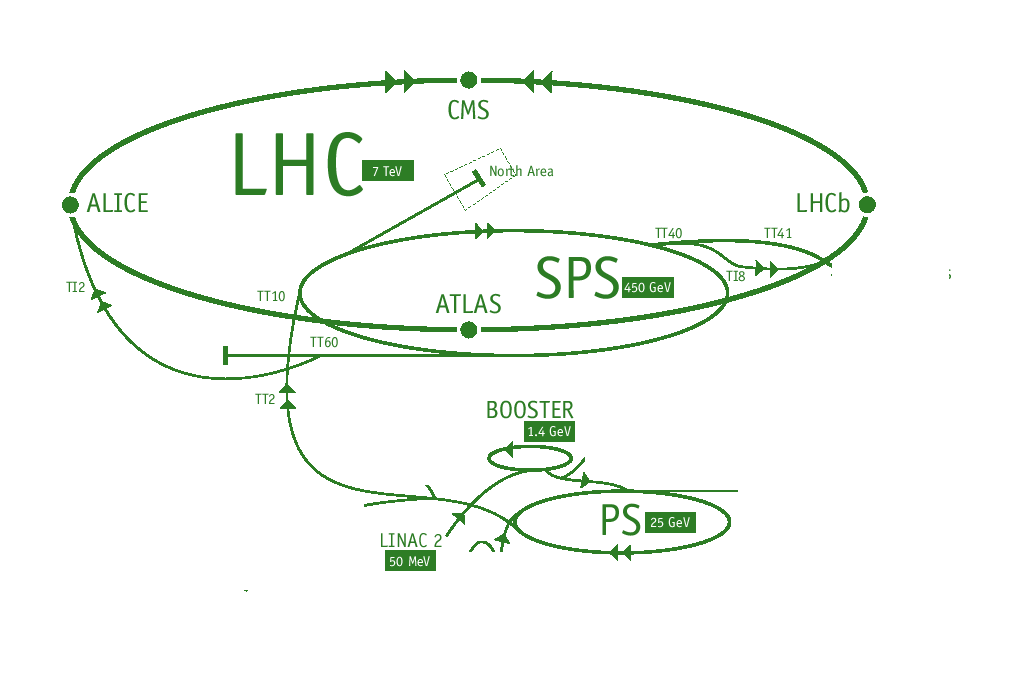
The protons are accelerated to speeds very close to the speed of light; they go so fast that they will complete over 11,000 circuits of the ring each second! The kinetic energy of each proton reaches roughly 7 Tera-electron volts, or 7 TeV for short. When two protons collide head-on, the total energy in the collision is 14 TeV.
The idea is that in the aftermath of the collision, many exotic sub-atomic particles may be created. The larger the energy of the collision, the more massive the particles which can be created. Remember,
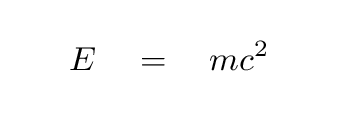
Ordinary particles have relatively small masses. For example,

A collision with total energy of 1 TeV would be able to create hundreds of protons, or hundreds of thousands of electrons. But the goal of the particle physicists is to find much more massive particles, such as the elusive Higgs Boson. That particle is predicted by some theories to have a mass of about 130 Gev ... but it has not yet been observed, so this number is very uncertain. The Tevatron experiment at Fermilab caused collisions with total energy of about 2000 GeV = 2 TeV, but it did not find any strong evidence for Higgs Bosons.
When the LHC is working properly, it will send two beams of protons into each other. The total energy of the collision, 14 TeV, should be enough to create a Higgs Boson every now and then. Clumps of protons within the intersecting beams should lead to about 600 million collisions each second, of about 20 trillion collisions over the course of a typical 10-hour run. There are four main detectors along the circumference of the LHC to detect particles created in these collisions. They will produce roughly 700 MBytes/second of data, which means about 25,200,000 MBytes per run. That's 25.2 Terabytes, or a lot of big hard drives....
If current theories are correct, hidden among those 20 trillion collisions might be 3 or 4 which create a single Higgs Boson each.
Some people are worried that these collisions, which are more energetic than any yet created in particle accelerators, might somehow cause big problems.
How? Some claim that a black hole might be created in the collision, and then that the black hole would eventually consume the Earth.
See the article mentioned in For more information for a detailed analysis of what would happen _if_ a black hole were to be created.
However, let me provide a reason why we should not even bother worrying about the possibility.
Gamma rays are photons with very high energies. They can be created in violent events such as supernova explosions, then travel for ages through the universe. Some of them run into the Earth, or, more properly, the Earth's atmosphere.
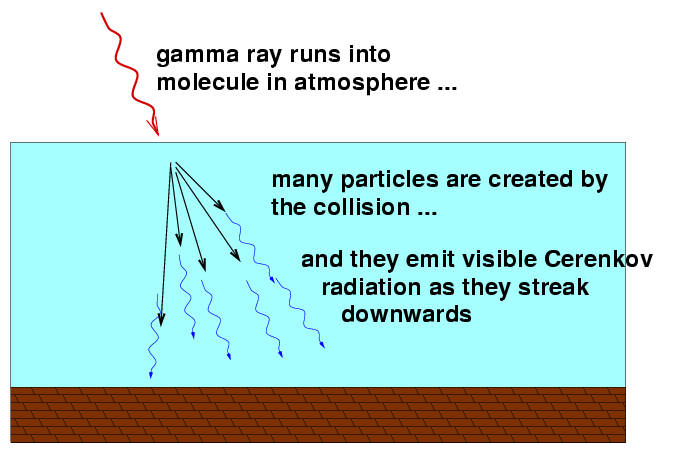
Some astronomers study these collisions by looking at the by-products: either the new particles created in the collision, or the optical photons emitted by those new particles as they fly through the atmosphere at superluminal (in the atmosphere) speeds.
Here are some pictures from one such observatory, the VERITAS array near Tucson, Arizona.
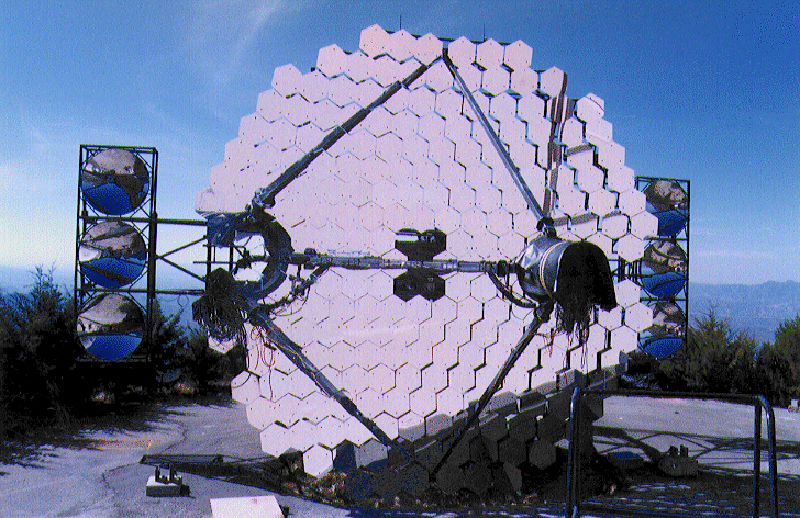

Over the past few decades, astronomers who study high-energy gamma rays have found some which have very large energies.
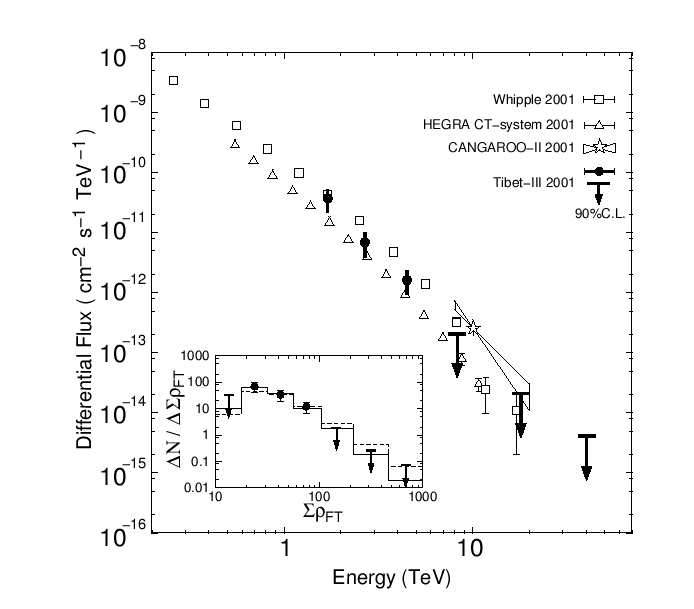
Note that the largest energies shown in the spectrum above are about 20 TeV. That's larger than the total energy of the proton-proton collision in the LHC.
Now, these high-energy gamma rays aren't observed very often. The gamma-ray telescopes need to watch for days (nights, actually) in order to detect a few. But they are watching only a small fraction of the entire atmosphere ...
Let's see: suppose that one 20 TeV gamma ray strikes a portion of the atmosphere which is 100-km by 100-km in size, once per week. The total surface area of the atmosphere is about 5 x 10^(14) square meters, which is about 50,000 times larger than that square patch. So, we might estimate that 50,000 very high energy gamma rays strike the entire atmosphere every week. That means over 2.5 million per year, or 2.5 x 10^(15) such energetic particles over the past billion years.
If that many collisions involving even higher energies than the LHC have occurred, and no black holes have yet consumed the Earth .... then I, for one, wouldn't worry about things when the LHC is turned on.
 Copyright © Michael Richmond.
This work is licensed under a Creative Commons License.
Copyright © Michael Richmond.
This work is licensed under a Creative Commons License.